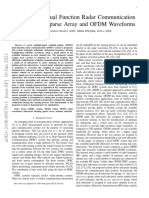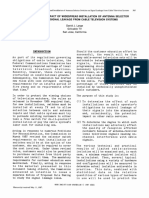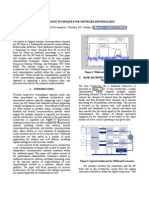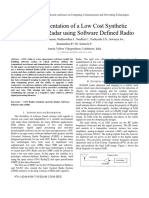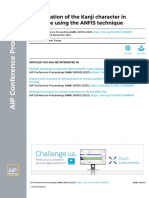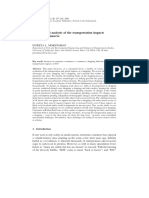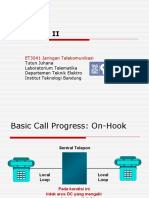Abstract
– In this paper a flexible radio approach for opportunistic access to the television white space (TVWS) is presented. Requirement stems from the coexistence scheme used in this band between opportunistic transmission and TV broadcast signals (or wireless microphones). To ensure non harmful interference of the TVWS signal on the incumbent services, a high adjacent leakage power ratio (ACLR) is expected. Also, flexibility is required to address the vacant channels in the UHF spectrum. Flexibility and low ACLR specifications are difficult to obtain simultaneously. The approach proposed in this paper is based on filter bank multi-carrier modulation (FBMC) scheme and a flexible hardware platform that combines RF agility and the digital filtering capability of FBMC. The hardware implementation validates that both flexibility and ACLR performance of the system are preserved even when off-the-shelf components impairments are considered. An experimental setup validates the coexistence with a TV broadcast signal and a comparison with a classical approach shows the gain in performance.
Keywords - Cognitive Radio; Flexible Digital Radio; TVWS; ACLR; FBMC
I.
I
NTRODUCTION
In 2009, the US radio regulator – the Federal Communication Commission (FCC) – authorized opportunistic unlicensed operation in the TV bands [1][2]. Such opportunistic communication systems have to coexist with TV broadcast signals and wireless microphones (referred to as ‘incumbent systems’ hereafter). The coexistence scheme is enforced with a priority mechanism where opportunistic systems must guarantee that no ‘harmful interference’ will be incurred to the incumbents. Such rules are meant to allow the control of the deployment and use of the unlicensed service so as to avoid harmful interferences on incumbents, but not to restrict it [3]. With the FCC rules harmful interference is defined in a twofold way. First, co-channel communication between incumbent and opportunistic systems is prohibited. This means that opportunistic systems must be able to assess the presence of incumbent signals and access only channels vacant from any incumbent. Besides, opportunistic systems have a limited amount of time to evacuate the channel when an incumbent is switched on. Secondly, adjacent channel leakage ratio (ACLR) is limited in order to prevent an opportunistic system from interfering with an incumbent operating in an adjacent channel. In [2], ACLR is restricted be at least 55dB. Similar requirements are about to be adopted in other countries (e.g. in the UK [4]). Such a high ACLR requirement is specific to the TVWS context. For instance, ACLR requirement is 10dB stronger than the one set for LTE systems. From these requirements, it can be concluded that an opportunistic system must be agile in frequency, as the operating channel may change according to the location and time of operation. Since the UHF band spans across a large frequency range (typ. 450MHz to 790MHz), this agility constraint implies using a tunable mixer in the RF. Besides, ACLR must be high enough to meet the 55bB requirement. Unfortunately, high ACLR values are usually obtained with SAW or BAW filters which frequency agility is very limited. Therefore, another radio architecture to address dynamic spectrum access (DSA) in the TVWS band is needed. In this paper we show the advantages of the filter bank multi-carrier modulation (FBMC) air interface to tackle these challenges. This is addressed in section II. It is shown that the filtering scheme embedded in the modulation itself guarantees high ACLR and relaxes the constraints of the analog filtering. In order to meet the TVWS requirements, the hardware implementation is crucial. In this paper, the frequency agility is provided by the hardware platform and it is important to show that the hardware implementation does not degrade the ACLR performance too much, even when standard low cost components are selected. The implementation of the FBMC transmitter on the TVWS flexible platform T-FleX [8] is described in section III. Finally, in order to prove the innocuousness of the opportunistic transmitter towards the incumbent systems, a hardware setup where adjacent coexistence with a TV broadcast service is demonstrated and quantified. This is presented in section IV. II.
TVWS
OPERATION WITH
FBMC
A.
TVWS limitations with OFDM
Several scenarios have been investigated for TVWS operation. In [9] and [11], the need for broadband systems is emphasized, where the radio system shall guarantee few Mbps to few tens of Mbps. Usually, such scenarios are covered by multicarrier systems using frequency multiplexes transmitted simultaneously over several subcarriers. The most classical approach is to use orthogonal carriers. With such a technique, referred to as orthogonal frequency division multiplex (OFDM), the receiver can equalize each subcarrier independently. When the system is adequately specified, each subcarrier is processed as a narrow band signal under flat fading condition, despite the broadband nature of the overall multiplexed signal. This property leads to a simplified receiver architecture even when frequency selective channels are considered. As a consequence, OFDM has
A Flexible Radio Transmitter for TVWS based on FBMC
Vincent Berg, Jean-Baptiste Doré and Dominique Noguet
CEA-LETI, Minatec Grenoble, France e-mail: vincent.berg@cea.fr, jean-baptiste.dore@cea.fr, dominique.noguet@cea.fr
2013 16th Euromicro Conference on Digital System Design
`/13 $26.00 © 2013 IEEEDOI 10.1109/DSD.2013.25163

been the initial choice for almost all modern broadband wireless systems, such as WiFI, WiMAX, 3GPP LTE, DVB-T, etc. The OFDM signal is represented in equation 1.
∑
−=∆
=
10.2
],[1],[
N k T f N k i j
s
ek n s
N ind
π
(1) where the subcarrier spacing
∆
f = 1/T
s
in order to preserve orthogonality between carriers. The major drawback of OFDM relies in its spectrum shape. Each rectangular shaped subcarrier in the time domain, results in an
sinc(f)
function in the frequency domain, which summation reveals high spectrum sidelobes (first lobe at -13dB). Usually, this issue is solved by filtering sidelobes with analog SAW filters at the RF transmitter. Unfortunately, this results in non-agile radios as analog filters are not flexible enough. It can also be stressed that OFDM is applied to systems where the spectrum mask is smoother than the one of the TVWS. In the case of the TVWS both frequency agility and sharp spectrum roll-off are expected. The agility requirement stems from the wide frequency span of opportunistic channels across the UHF band (this depends on the country but typ. 450MHz to 790MHz), and the sharp roll-off is requested to guarantee coexistence with adjacent incumbents, which translates into ACLR specifications. In order to avoid non agile RF filters, spectrum sharpness may be tackled by implementing the filter in the digital domain. Then, the filter is implemented after the iFFT of the OFDM modulator. However, it was shown in [5] that the complexity of the filter increases dramatically as the guard band is reduced (i.e. the complexity increases with the filter frequency steepness). This is illustrated in figure 1, where the complexity of filtered OFDM under TVWS spectrum mask is compared to the one of a 1024-FFT alone as a function of the used portion of the channel in terms of number of real multiplication. The calculation was achieved for an 8MHz channel with 15kHz subcarrier spacing and an equiripple filter (0.5dB in band ripple) under 55dB ACLR condition.
Figure 1: Complexity of filtered OFDM in terms of number of real multiplication to meet TVWS ACLR requirements.
It can be observed that the complexity of the filter to meet the ACLR specification is very significant. The complexity of the filter is already similar to the one of the iFFT when only 40% of the channel is exploited. It is 10 times as high when the occupation reaches 85%.
B.
TVWS fragmented spectrum access
Due to the TV broadcast planning, the TVWS is fragmented. This means that the broadcast multiplex cannot be predicted. In some places, contiguous available channels are virtually inexistent. The situation in London is highlighted in [6], but similar fragmented available spectrum can be observed in many locations. In order to enable broadband services under such conditions, the spectrum pooling approach is envisaged [9]. It consists of using the parallel nature of the multiplex to switch off the subcarriers to avoid interfering with an in-band incumbent. Ideally, this technique should enable to create deep notches and should not impact the transmission on the active subcarriers as each subcarrier is processed individually. However, with the OFDM waveform, similar smooth roll-off is observed where notches are enforced. Unfortunately, the filter designed to steepen the edges of the spectrum (see above) does not have a positive impact on the notch [5]. Thus, on top of its large complexity the digitally filtered OFDM does not have the flexibility to address TVWS fragmented spectrum.
C.
FBMC operation for TVWS
An alternative modulation scheme is proposed to solve these issues by combining filtering and multicarrier modulation techniques. This technique was introduced in the 60’s by Chang [12] and Saltzberg [13], but has been revisited recently in the context of TVWS in [5]. This approach, also known as filter bank multi-carrier (FBMC) allows the control of the frequency response of each carrier by introducing a filter bank, centered on every active carrier and based on the same prototype response, which can be used to control adjacent leakage, and even to virtually null it. Because the prototype filter spans across several subcarriers, the neighbouring subcarriers are no longer orthogonal but orthogonality can be restored by introducing an offset quadrature amplitude modulation (OQAM) [14]. It should be mentioned that FBMC and OFDM schemes exhibit similar Peak-to-Average Power Ratio (PAPR) performance [15]. III.
F
LEXIBLE IMPLEMENTATION OF A
TVWS
TRANSMITTER
Although the result provided in [5] were very promising, it is important to assess the results with an actual implementation of the FBMC transmitter. Considering the very stringent requirements on ACLR considered, finite dynamic range computation in the modulator must be accounted for. Similarly, the noise introduced by analog to digital converters (ADC) must be considered. Finally, signal generation with an actual RF circuitry using affordable components is necessary to show that the approach has some realistic potential. A preliminary implementation of the FBMC transmitter on the TVWS Fexible radio system (T-FleX) was introduced in [8]. The T-FleX system is a TVWS flexible digital radio including digital processing capacity (Xilinx Kintex7, ARM cortex A8, OMAP DSP), ADC and DAC converters, and RF front end TRX stages. The block diagram of the T-FleX system is shown in figure 2.
164
Camera Connector JTAG Xilinx JTAG ARM
Texas DM3730 Xilinx XC7K325T
Flash PROM Xilinx XCF128X Buffer RS232 Quad DAC AD9148 2 dual ADC AD9643 Rx I/Q Tx I/Q Quartz: 32,768 kHz 26 MHz 2 Gbits LPDDR SDRAM 4 Gbits Nand Flash USB Link OTG
PC
PHY MAC LAN9220 Clocks generator AD9516-0
RF Board
JTAG ARM: XDS560 Emulator JTAG Xilinx: USB Xilinx Probe
TiWi-R2 WiFi module External Flash Memory µSDcard DVI Digital Visual Interface
Ethernet 10/100 Mbits/s
clocks Oscillators
High-speed USB 480 Mbds
Figure 2: Digital architecture of T-FleX.
The digital board is interfaced to the RF TX daughter board in order to generate UHF (Ultra High Frequency) signal. The ARM processor controls the digital board and the RF Boards and interfaces to an external PC via either a USB, an Ethernet or a Wi-Fi connection. The transmitter covers a 40MHz window (equivalent of 5
×
8MHz TV channels) that can be tuned within the whole UHF band from 470MHz up to 860MHz in a flexible way. Within the 40MHz window, the signal channelization is performed directly with the FBMC modulation by nulling unwanted carriers, i.e. using the spectrum pooling method. There is no additional filtering on the channelization path, neither in the digital domain, nor on the RF board, leaving the entire subcarrier allocation flexibility to the digital FBMC modulator. The bottom view of the T-FleX system and the TX RF daughter module is shown in figure 3.
Figure 3: T-FleX hardware bottom view.
IV.
FBMC
VALIDATION TESTBED AND RESULTS
A.
Test setup
The validation of the flexible TVWS FBMC transmitter is carried out in a twofold way: through spectrum profile measurements and by observing the impact of adjacent opportunistic communication on a TV broadcast signal. Thus, the setup of the validation testbed involves the TVWS transmitter and a DVB-T modulator, which signals are combined to share the same medium. Then, the compound signal is split to be visualized on a spectrum analyzer on one hand and to a TV demodulator on the other hand. This setup is illustrated in figure 4.
Figure 4: Validation testbed setup.
An attenuator is placed at the output of the RF transmitter in order to adjust the TVWS vs DVB-T relative power. An interesting setup consists in adjusting the TVWS transmission power in order to be on the limit of the DVB-T receiver performance. This limit is sometimes called Quasi Error Free limit, when a DVB-T service is available in presence of adjacent signal. It also enables to compare the respective impact of OFDM and FBMC on the DVB-T television demodulator. The TVWS opportunistic transmitter implemented on the T-FleX system can be configured either in CP-OFDM or FBMC mode. With the digital flexible transmitter, subcarriers can be switched on or off by blocks of 2MHz in a global window of 20MHz. This enables to implement spectrum pooling features to avoid interfering with in- band incumbent transmission. In both the CP-OFDM and the FBMC case, the subcarrier spacing is set to 15kHz (similar to the one of 3GPP LTE systems). The total number of active carriers depends on the configuration which can be set though a GUI displayed on a host device.
B.
ACLR measurements
First, ACLR is measured without the DVB-T transmitter. This enables to avoid the saturation of the spectrum analyzer while maintaining its noise floor to a low level. This makes the spectrum analyzer maximal dynamics available for the ACLR measurement. This is required for the high dynamic signal (>50dB) that need to be measured. The result is shown in figure 5, where the upper curve corresponds to the transmitter switched in OFDM mode whereas the lower curve corresponds to the FBMC case. It can be observed that the roll-off of the FBMC modulation if far steeper than the one of CP-OFDM. This confirms the simulations presented in [5]. ACLR measured between the two markers that are visible on the plot reveals an ACLR value of 55.6dB, which is in line with the FCC specification; although no RF filtering is added on top of the FBMC modulation.
165
Figure 5: ACLR measurement for the FBMC modulation.
The second test is to measure the ability of FBMC to carve deep notches in the spectrum profile. This is illustrated in figure 6, where OFDM and FBMC are compared again. FBMC exhibits very steep in-band and out-band roll-offs. Moreover, the spectrum shape shows a clean flat profile inside the in the notch. Therefore, potential interference in the notch is expected to be similar to the one in the adjacent channels. On the contrary, OFDM neither manage to reach the same flatness, nor a low interference level even at its lowest point, which is some 20dB above the FBMC floor. The measured ACLR in this case is not as good as in the previous case. This is due to the fact that twice the power is present at the input of the spectrum analyzer, which impacts the dynamic available for the measurement.
Figure 6: Spectrum pooling measurement with CP-OFDM and FBMC.
A.
Impact on DVB-T incumbent signal
A comparison with OFDM is also performed to measure the impact on a DVB-T reception and the potential interference of the TVWS transceiver onto the incumbent signal. The measurement has been performed with a low cost USB DVB-T demodulator centered at 642MHz (Channel 42). This kind of demodulator is more sensitive to interference than better quality TV tuners. When using direct adjacent channels on both sides of the DVB-T signal (64QAM 7/6), the OFDM signal must be attenuated by 9 dB in comparison to the FBMC signal in order to get a quasi-error-free DVB-T service. Figure 7 shows a measured plot where the DVB-T signal (at the center) is combined with either an OFDM signal (lower plot) or an FBMC signal (higher plot). In both cases, the power is adjusted to get the quasi-error-free situation.
Figure 7: CP-OFDM and FBMC in presence of a DVB-T signal.
The 9db margin measured on this setup can be used either to increase the transmitted power of the opportunistic TVWS system or as an extra protection margin for the DVB-T receiver, or as a combination of both. A zoom of the transition zone between the TVWS signal and the DVB-T signal is shown in figure 8, for the CP-OFDM and the FBMC cases.
Figure 8: Zoom of the transition zone between the TVWS transmission and the DVB-T signal.
V.
C
ONCLUSION
In this paper, the opportunistic use of TVWS in presence of incumbent systems was discussed. Two major requirements have been stressed. These are the stringent ACLR performance of the TVWS transmitter that must be guaranteed to avoid interference with adjacent incumbent services and the flexibility required to address available channel, which map varies across time and space. Both requirements are unusual in wireless systems, where operating frequencies are typically known in advance and where ACLR constraints are relaxed (e.g. WiFi, LTE).
166
















